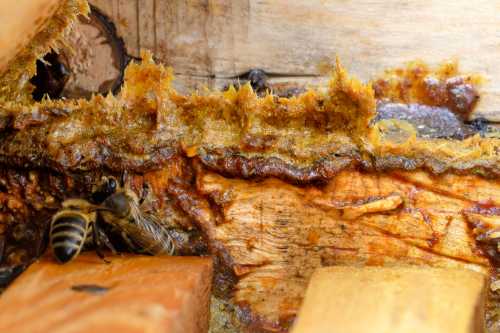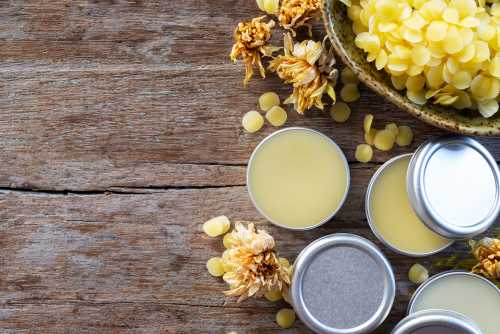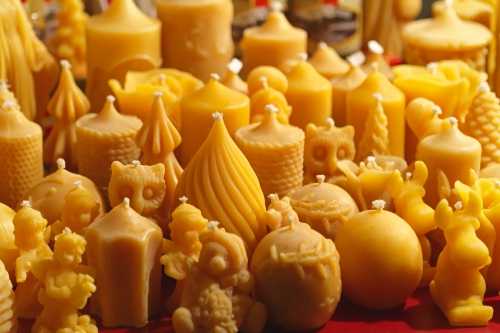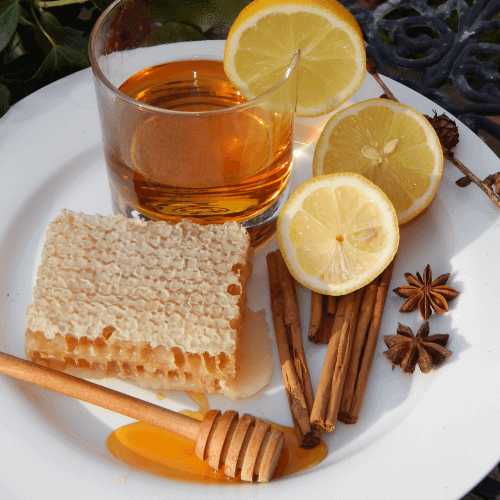Beeswax Benefits For Skin
Beeswax has been used on skin since the time of the ancient Egyptians, when it was made into ointments and creams, but it is also widely used today in the same way, including in pharmaceutical preparations.
Beeswax was even a component of the first cosmetic cream, which was created by the Greek physician, Galen, in 150 B.C1. There is a recipe for this cream (Galen's Cold Cream - or Unguentum Refrigerans or Ceratum Galeni) below.
Why is Beeswax Good For Skin?
Beeswax is collected by beekeepers and apiarists following the process of harvesting honey.
It is a natural substance produced by honey bees from glands located in the abdomen.
In cosmetics, beeswax is mainly used as an emulsifying agent, stiffener, and gentle skin adhesive2. In lip balms, it also provides a protective coating to help lips retain moisture and protect from the elements.
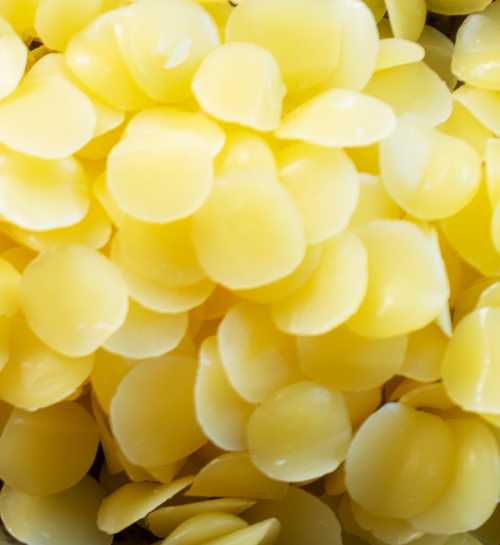
1. Moisturizing and softening
Beeswax has lubricating, softening activities and reduces transepidermal water loss from skin2.
2. Antibacterial benefits
Squalene, 10-hydroxy-trans-2-decenoic acid and flavonoids are among the components of beeswax that provide antiseptic properties, thus helping to protect the skin against pathogenic microorganisms2.
3. Anti-aging effects
"β-carotene present in beeswax is a valuable source of vitamin A, into which it is converted. Vitamin A delays collagen degradation, stimulates mitotic division in the epidermis, thus leads to sooner regeneration of the skin after damage."
- Kurek-Górecka et al2
Is beeswax comedogenic
Does beeswax clog pores?
If you are prone to acne, clogged pores and blemishes, you may be concerned about whether beeswax is comedogenic (i.e. clogs skin pores).
An organization called Acne.org3 have looked at a variety of studies and ingredients. In a 1972 study referenced by the organisation, it was shown that beeswax has a low comedogenicity score (actually a score of Zero out of 3), however, you should always check the other ingredients it is combined with.
Flavonoids and phenolic acids in beeswax and their beneficial effects
The following table is adapted from Kurek-Górecka et al2.
Please note that although beeswax has some UV photoprotective properties, the strength of that protection is not indicated, and therefore, beeswax preparations should not be used as a substitute for sunscreens.
| Group | Representative | Effect |
|---|---|---|
| Flavones | Chrysin | anti-inflammatory |
| antibacterial & antiviral | ||
| antioxidant | ||
| Apigenin | antiviral & antifungal | |
| anti-allergic | ||
| antioxidant | ||
| Flavonols | Galangin | antiviral |
| antifungal | ||
| antioxidant | ||
| Kaempferol | anti-inflammatory | |
| antifungal & antiviral | ||
| antioxidant | ||
| UV photoprotective | ||
| Quercetin | anti-allergic | |
| antiviral & antifungal | ||
| antibacterial | ||
| antioxidant | ||
| UV photoprotective | ||
| anti-inflammatory | ||
| Flavanones | Pinocembrin | antifungal |
| antioxidant | ||
| Naringenin | UV photoprotective | |
| antioxidant | ||
| anti-inflammatory | ||
| antiviral | ||
| Phenolic acids | p-Coumaric | antiviral |
| antibacterial | ||
| Caffeic | anti-inflammatory | |
| antiviral | ||
| antibacterial | ||
| antifungal | ||
| Ferulic | antibacterial | |
| photoprotective |
Beeswax skin cream recipes and rubs
Here are 3 simple recipes for you to try. You can tweak them to suit your own preference in terms of thickness and added oils.
Beeswax and almond oil for the body
Ingredients:
100grams beeswax
100grams cocoa butter
125ml almond or olive oil
Add a few drops of essential oil, such as lavender or geranium, and a few drops of other oil, such as wheat germ or vitamin E.
Melt the cocoa butter and beeswax gently in a double boiler, add the almond oil and essence, stir, and poor into a jar to cool.
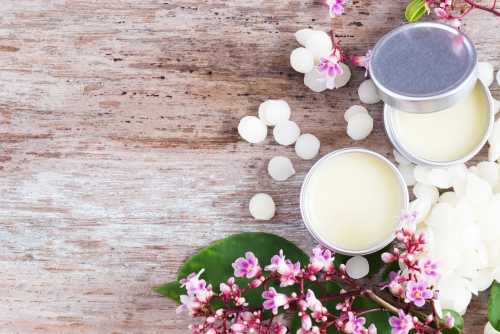
Beeswax and rosewater
Ingredients:
125ml almond oil
65ml of rosewater
30g grated beeswax
Heat the ingredients gently and together in a double boiler while stirring. Dispense into appropriate container.
Galen's Cold Cream containing beeswax - Unguentum Refrigerans / Ceratum Galeni
From: The American Journal Of Pharmacy, January 1870, a contribution by J.B. Moore states4:
"As a matter of curiosity, and to show to those who are not already aware of it how this ointment was prepared in the days of 'gore, I will append a formula which I copy from an old and valued relic in the possession of the writer, a copy of an old London Dispensatory, edited by Nicholas Culpeper, published in the year 1650, and now nearly 220 years old."
Culpeper's formula was written as follows:
" Unguentum refrigerans, Galenus.
It is also called a cerecloath. Take of white wax four ounces, oyl of roses omphacine a pound; melt in a double vessel, then powr it out into another, by degrees putting in cold water, and often powring it out of one vessel into another, stirring it till it be white; last of all wash it in rose water, adding a little rose water and rose vineger.
It is a fine cooling thing, (for what denomination to give it I scarce know) and exceeding good, yea super-excellent to cure inflamations in wounds or tumors."
— Nicholas Culpeper (1650), London Dispensatory
More adds: "The above, I presume, is the original formula of Galen".
References
1. R.J. Stacey Composition of some roman medicines: evidence for Pliny's punic wax? Anal Bioanal Chem, 401 (2001), pp. 1749-1759.
2. Kurek-Górecka A, Górecki M, Rzepecka-Stojko A, Balwierz R, Stojko J. Bee Products in Dermatology and Skin Care. Molecules. 2020;25(3):556. Published 2020 Jan 28. doi:10.3390/molecules25030556
3. Dan Kern, What Is Comedogenicity, and What Ingredients Are Comedogenic? The Full Story, Acne.org. From updated version: May 05, 2020. Adapting Kligman, A. M. & Mills, O. H. Acne cosmetica. Arch Dermatol 106, 843 - 850 (1972). https://www.ncbi.nlm.nih.gov/pubmed/4264346
4. Recounted in Moore, J. B. (1869) [1870]. "On Cold Cream". American Journal of Pharmacy. Philadelphia College of Pharmacy: 63.
If you found this page helpful or interesting, I'd really be grateful if you would share it with others - if not this page, perhaps another, such as Gardening For Bees.
Thank you so much :) .
